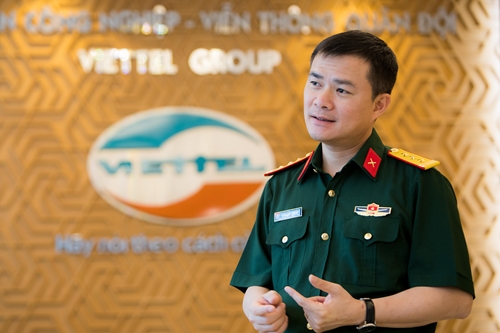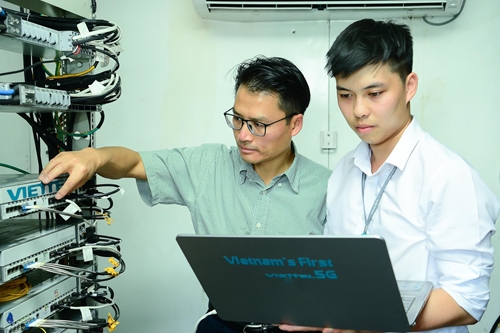    |
 |
|
Colonel Tao Duc Thang, Deputy Director of Viettel Group |
The way to tap the potential of the 5G network is quite different from the previous network. It not only offers higher speed, but also includes the whole eco-system of new solutions. Colonel Tao Duc Thang, Deputy Director of Viettel Group, granted the People’s Army Newspaper an interview.
Reporter: Viettel has just conducted the first piloted calls via the 5G network. What do you think is the speed of the 5G call compared with that in other countries?
Colonel Tao Duc Thang: Viettel was licensed to piloting the 5G mobile network on January 23. Viettel is the first service provider in Vietnam allowed to pilot the network and it is also the one to conduct the first 5G call in Vietnam on May 10. Previously, Vietnam started the 2G, 3G and 4G networks from seven to 10 years later than other countries in the world. Now Vietnam is among the first countries to put the 5G network into use, just after the Republic of Korea, the US, Japan and Australia. At the recent Mobile World Conference, 5G devices were just on display, and now it can be said that Viettel goes along with the world in deploying 5G networks.
Reporter: Viettel mobilized all of its forces to put its 4G network into operation nationwide. Will you do the same with the 5G network?
Colonel Tao Duc Thang: We will initially implement the 5G network according to demands, which means the network will be carried out in areas of high demand. That is because at present the 4G network has covered all localities of the country basically meeting customers’ need for high-speed internet. The 5G network will cover big cities, smart factories, hospitals, schools, research institutes, and places in need of especially-high speed internet with high capacity and little time lag, capable of real-time video broadcasting to serve new technologies. Therefore, Viettel will not implement the 5G network en mass, but in accordance with customers’ demand.
Reporter: Some people say that the number of subscribers shifting from 2G and 3G services to 4G ones is not up to expectation. Many subscribers still stick to 3G and even 2G services. So, is it necessary to deploy the 5G network by now?
Colonel Tao Duc Thang: By the end of April 2019, Viettel had had 17 million 4G subscribers. It is estimated that by the end of this year, the figure will have mounted to 24 million. That shift is fast. The 4G mobile network helps subscribers look up information and entertain themselves much more conveniently, and this in return boosts the development of the IT sector of Vietnam and promote the digital economy and society.
It must be made clear that 3G and 4G networks only mark the advances in the speed of telecommunications data transfer, meeting the usual need of users, not capable of meeting the need of smart production and robot industry. As for the 5G network, it is really a revolution as the connection speed recorded during the pilot reached 1.5 – 1.7 Gbps, more than 40 times faster than the speed of 4G and more than 100 times faster than that of the 3G network. In the radius of 1km, the 5G network is capable of serving one million terminal devices, which is especially important to push forward the development of the Internet of Things (IoT). It is not simply the matter of “higher” or “lower” speed of data transfer, but a total difference of “present” or “nothing.” For a country to surf the wave of Industry 4.0, the 5G network is a must.
In the official report submitted to the Government Office in July 2018 on the research and implementation of the 5G network, the Ministry of Information and Communications clearly pointed out the development trend of the digital eco-system and services and applications on the IoT platform, big data and artificial intelligence. The 3G and 4G networks cannot meet the requirements of that digital eco-system; therefore, the implementation of the 5G network aims to meet those requirements and embark on the development trend of present and future.
Reporter: To ensure the 5G network’s sizeable effects, there must be an eco-system of 5G-applied industries. What has Viettel prepared for that?
Colonel Tao Duc Thang: Viettel has applied technical solutions on the 4G platform to implement IoT connection and expanded other technical platforms for IoT. We will bring a playground for inventors to hammer out solutions meeting people’s and society’s demands based on IoT connection. On the 4G platform, Viettel has built solutions such as smart parking, surveillance camera systems, electricity counter on smartphones, etc.
The 5G platform will bring dominant power for future solutions. However, whether the development of the 5G network at present can change the production and life depends much on application developers. The high speed of data transfer, low time lag and massive connections are the advantages of the 5G network and help develop more applications to settle issues of production and in the society. Viettel alone cannot facilitate more applications to connect to the eco-system. There should be more companies to share the job of providing 5G services with Viettel. The Ministry of Science and Technology has just established the IoT Innovation Center, serving as the basis to further boost innovative ideas based on IoT.
As for service providers, Viettel will support platforms and data lines. At present, startups have well understood advantages of the 5G network. The point is that they have to really move to develop their applications.
    |
 |
|
The operation of 5G network is considered a revolution that builds digital society |
Reporter: What challenges do you think Viettel has to overcome in developing that eco-system?
Colonel Tao Duc Thang: At present, Viettel is piloting the 5G services at a small scale. When officially put into operation, the network requires its own frequency suitable with the 5G network. The biggest challenge for us is to find a suitable frequency for the network, as Minister of Information and Communications Nguyen Manh Hung said that the frequency for the 5G network must be 10 times that for the 4G network. Therefore, there should be an auction for 5G frequency soon.
The 3500 MHz frequency band has the same structure as that of the 2100 - 2600 MHz frequency bands and can be installed at existing stations. However, for super-high frequencies like 28 GHz band, service providers must develop new network structures with indoor and thick stations and other suitable devices to prevent the signal from being depleted completely.
Reporter: Thank you very much!
Translated by Huu Duong